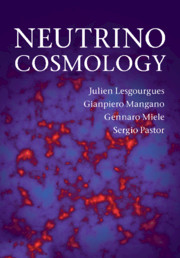Book contents
- Frontmatter
- Contents
- Preface
- 1 The basics of neutrino physics
- 2 Overview of the Standard Cosmological Model
- 3 Neutrinos in the early ages
- 4 Neutrinos in the MeV age
- 5 Neutrinos in the cosmic microwave background epoch
- 6 Recent times: neutrinos and structure formation
- 7 Cosmological neutrinos today
- References
- Index
2 - Overview of the Standard Cosmological Model
Published online by Cambridge University Press: 05 March 2013
- Frontmatter
- Contents
- Preface
- 1 The basics of neutrino physics
- 2 Overview of the Standard Cosmological Model
- 3 Neutrinos in the early ages
- 4 Neutrinos in the MeV age
- 5 Neutrinos in the cosmic microwave background epoch
- 6 Recent times: neutrinos and structure formation
- 7 Cosmological neutrinos today
- References
- Index
Summary
Cosmology is the quantitative study of the properties and evolution of the universe as a whole. Since the discovery of the redshift–distance relationship by Hubble in 1929, observations have supported the idea of an expanding universe, which can be beautifully described in terms of the Friedmann and Lemaître solution of the Einstein equations. The basis of this solution is the empirical observation that on sufficiently large scales, and at earlier times, the universe is remarkably homogeneous and isotropic. This experimental fact has been promoted to the role of a guiding assumption, the Cosmological Principle. Assuming that our observation point is not privileged, in the spirit of the Copernican revolution, one is naturally led to the conclusion that all observations made at different places in the universe should look pretty much the same independent of direction. Homogeneity and isotropy single out a unique form for the spacetime metric, the basic ingredient of Einstein theory. Cosmological models can then be quantitatively worked out after specification of the matter content, which acts as the source for curvature. Results can be then compared with astrophysical data, which in the last decades have reached a remarkable precision.
Actually, the Cosmological Principle works only on scales larger than 100 Mpc, yet it is a powerful assumption. In fact, several observables, such as the distribution in the sky of the cosmic microwave background (CMB), show inhomogeneities which are quite small, so that they can be treated as perturbations of a reference model (i.e., a reference metric) which is homogeneous and isotropic.
- Type
- Chapter
- Information
- Neutrino Cosmology , pp. 53 - 105Publisher: Cambridge University PressPrint publication year: 2013



